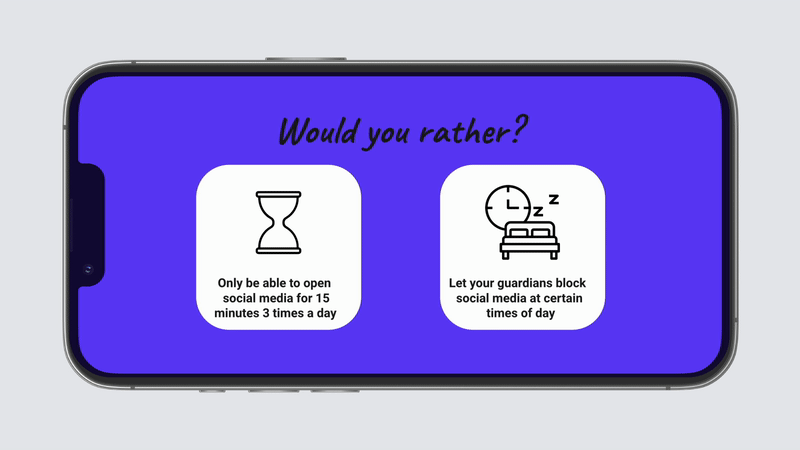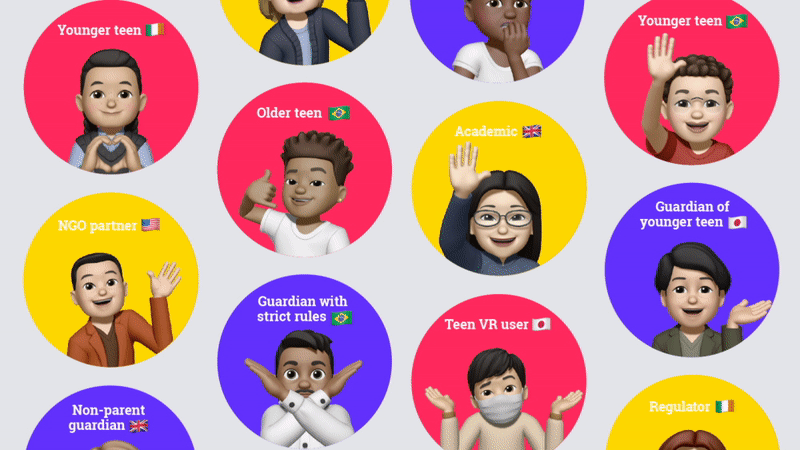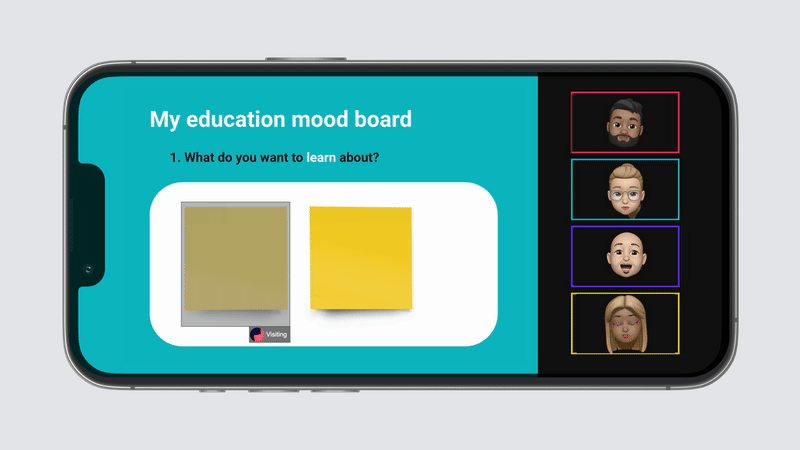Designing digital products for young people presents unique challenges. As obvious as it may seem, it can be easy to forget that teens are not miniature adults, but a population with distinct and rapidly-evolving needs, goals and motivations. As product makers, we also recognize that we don’t have all the answers, and that gathering young people’s perspectives on the technologies that impact their lives is essential to ensuring their needs are met.
Parents and guardians have a central role to play in supporting teens online. Yet, we know they often feel overwhelmed by the pace of technological change and may lack the confidence or resources to play an active role in teens’ digital lives. Every family is unique, and it’s important to listen to and learn from parents/guardians about the kinds of customizable tools necessary for their teens to adapt and thrive.
Over the past year, Meta has been building Family Center - a new place for parents and guardians to support their teens online by accessing supervision tools and educational resources from leading experts. Since this product serves teens and parents/guardians, it was important that we included their voices and perspectives as part of the design and product development process.
What we’ve done so far
Through Meta’s partnership with Smart Design, a design and innovation agency, we’ve brought together teens, parents/guardians, academics, regulators and civil society to uncover product-relevant insights and principles. This initiative builds upon a multi-year effort by TTC Labs to co-design with experts for young people's privacy and safety.
So far, we’ve conducted co-design sessions with teens and parents/guardians in the US, UK, Ireland, Brazil, Australia and Japan, involving over 103 teens and 92 parents/guardians. These co-design sessions are paired with consultations with external experts from government, nonprofits and academics, who are invited to observe the research with teens and parent/guardians as well as participate in a dedicated experts session to provide feedback and explore co-design insights and dilemmas together.
Throughout this pilot program, we recruited in ways that gave us access to diverse families, allowing us to explore how variation in age, household structure, and level of parental oversight play out in teens’ and parents’ needs, motivation, and pain points. As practical constraints brought on by the pandemic made in-person research impossible, we conducted sessions remotely. While this forced us to get more creative in how we designed and facilitated these sessions, it also had the added benefit of being more inclusive, allowing us to speak with families without disrupting the rhythm of their daily lives and their obligations to school, work, or childcare.
We focused this first phase of the co-design program to help us explore key questions relevant to the design of Family Center, including how to:
-
Design for the diverse needs of teens, both within and across age groups
-
Account for vulnerable groups who might have particular privacy and safety needs
-
Enable young people to learn from peers, parents/guardians, and other trusted adults
-
Promote youth autonomy while considering the rights and duties of parents/guardians
-
Recognize and engage global youth and families using our products
As an approach to designing digital experiences, co-design offers a creative and inclusive way to listen to and elevate diverse perspectives as part of the product design process. In this article, we outline a few ways in which we used co-design methods to enable the meaningful participation of teens and parents/caregivers in the development of Family Center.
Exploring tensions and dilemmas
A core commitment of Meta’s “Best Interests of the Child” framework is to promote youth autonomy while considering the rights, roles and responsibilities of parents/guardians. Yet, knowing when teens need freedom and when they need age-appropriate oversight can be a tough balancing act. If teens’ online experience feels too restrictive, they may find ways to circumvent parental controls or not seek help or advice from their parents/guardians if they encounter challenges online. On the other hand, too much freedom can leave them feeling unsupported.
In co-design, we wanted to understand how teens navigate these dilemmas, trade-offs and tensions related to online parental supervision. We used Would You Rather, a popular conversational game, to combine design provocations and forced-choice scenarios (this game was originally adapted by Simko et al., 2021 for use as a co-design methodology). In the game, participants are presented with two unappealing options and have to pick among them (e.g. “would you rather say everything that’s on your mind or never speak again?”). Here, teen participants discussed different scenarios related to their use of social media, to uncover information about their needs, mental models and values, and to help illuminate which forms of parental supervision they deemed acceptable and which they deemed intrusive or counterproductive.
Asking teens to deliberate between two extreme and opposing scenarios helped reveal moderate solutions that were satisfying to them. For example, choosing between “only being able to access Instagram for 5 minutes every hour” and “having the entire platform shut down between 9pm and 6am” helped reveal teen participants’ preferences and pain points around having blocking hours or time limits imposed on their social media experience. One measure that Meta has taken with these co-design insights in mind is to build flexible controls that can account for situational context like weekdays, weekends and school holidays. Parents/guardians will now have the option to set daily time limits and/or schedule breaks for times when social media may be more likely to interfere with other responsibilities such as school, homework or sleep.

Tap into a range of expertise
Part of Meta’s commitment to building digital products for young people is to draw from different and complementary forms of expertise. In co-design we wanted to define the term ‘expertise’ broadly so we brought together people from different types of family situations, cultures, regions and backgrounds who could speak to us about their lived experiences, as well as those at the forefront of research and policy fields. Triangulating insights across these diverse expert groups helps us weigh different perspectives to help inform our product development process.
We customized each co-design activity for teens and parents/guardians in order to effectively understand how their opinions converge and diverge. One teen activity called You Make the Rules was geared toward understanding what sorts of parental insights were in-bounds and out-of-bounds. The activity proposed a set of hypothetical safety features (e.g. “block content that they don’t think is acceptable”), asked teens to rate how they felt about it, and then tasked them with creating a condition that would make each one more acceptable. The parent/guardian version of this activity, called Build Your Own Control Center, was designed to understand top parental priorities for their teens’ online safety. The activity offered up a range of hypothetical safety features and asked parents to organize them along a spectrum of personal importance, creating their own safety feature when a topic that was important to them was left out.
These paired activities helped reveal tensions between teen and parent/guardian priorities. In our research to date, we’ve found that guardians’ top priorities are to identify possible risks for their teens so they can intervene early. Teens, on the other hand, are most concerned about their own privacy and their ability to freely connect with peers.
While seemingly in conflict, this information helped us understand the sorts of parental insights Family Center should provide. For example, the ability for guardians to view and receive updates on what accounts their teens follow and the accounts that follow their teens is acceptable to teens. However, for parents to read teens’ direct messages felt like an unacceptable violation of privacy (as well as the privacy of those they were messaging). The importance of protecting teen privacy was echoed during consultation sessions with experts, many of whom were especially sensitive to the language around “controls” and the potential risks of overreaching parent supervision. Instead, many expert participants advocated for platforms to explore ways to encourage reciprocity through co-learning, co-creation and facilitation of conversations between parents/guardians and teens that pave the way for their evolving autonomy and empowerment.

Including varying levels of tech awareness and access
Conducting co-design during the pandemic meant we relied entirely on remote digital tools. Co-design is a generative form of research meant to inspire creativity and new ideas. The constraint of conducting these sessions on video calls meant we had to carefully consider how to make them engaging and also how to include people who had limited access to technology.
One way we adapted our approach was in optimizing the co-design activities for the mobile phone. We came to understand as the co-design became more global, that we could not assume all participants would have access to a device with a large screen. As a result all activities were adjusted to be mobile phone-friendly. In order to make the sessions engaging and dynamic we began to incorporate more physical gestures, like voting by touching your ear or your nose, which don’t depend on technology.
In one mobile-friendly activity called Build Your Educational Resource, we asked small groups of parents/guardians to agree on a social media related topic they would like to get more information about, and collaborate together on building out their own educational experience including where the information comes from, how it’s delivered and what makes this experience different and better.
By asking guardians to collaborate on an educational experience they would all value, we learned about their motivations, frustrations and needs. This gave us important direction in creating the education hub. For example, parents indicated that they often lack access to credible, trustworthy sources of evidence on social media, so we partnered with leading experts to help author the content. We also learned that parents/guardians want tools to have more targeted conversations that can make discussions around social media less adversarial. This led us to develop discussion guides so that parents/guardians are better equipped to handle difficult conversations around sensitive topics.

For more information
See our report which we published in December 2022 building on global research in 10 countries (US, UK, Ireland, Australia, Brazil, Japan, India, Mexico, Senegal and Côte d’Ivoire). We are publishing these insights in this report to share openly with the broader community of expertise around age-appropriate design.


